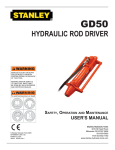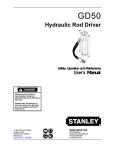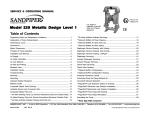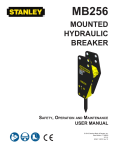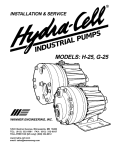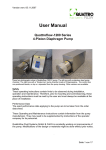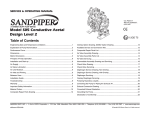Download WAGNER HIGH-PERFORMANCE AIRLESS SPRAYER Owner`s manual
Transcript
® F230 Airless Sprayer Owner’s Manual • Betriebsanleitung • Manuel d'utilisateur Manual de usuario • Manuale dell'utente • Gebruikshandleiding Ejermanual • Användarmanual English Deutsch Français Español p. p. p. p. Italiano Nederlands Dansk Svenska p. p. p. p. 50 62 74 86 0106 © 2006 Wagner. All rights reserved. Form No. 0508296A Printed in the U. S. A. GB 2 14 26 38 D F E I NL DK S The maximum operating range of the unit is 20.7 MPa (3000 PSI) fluid pressure. PREVENTION: • NEVER aim the gun at any part of the body. • NEVER allow any part of the body to touch the fluid stream. DO NOT allow body to touch a leak in the fluid hose. • NEVER put your hand in front of the gun. Gloves will not provide protection against an injection injury. • ALWAYS lock the gun trigger, shut the fluid pump off and release all pressure before servicing, cleaning the tip guard, changing tips, or leaving unattended. Pressure will not be released by turning off the engine. The PRIME/SPRAY valve or pressure bleed valve must be turned to their appropriate positions to relieve system pressure. Refer to the PRESSURE RELIEF PROCEDURE described in this manual. • ALWAYS keep tip guard in place while spraying. The tip guard provides some protection but is mainly a warning device. • ALWAYS remove the spray tip before flushing or cleaning the system. • The paint hose can develop leaks from wear, kinking and abuse. A leak can inject material into the skin. Inspect the hose before each use. • NEVER use a spray gun without a working trigger lock and trigger guard in place. • All accessories must be rated at or above the maximum operating pressure range of the sprayer. This includes spray tips, guns, extensions, and hose. Table of Contents Safety Precautions .................................................................2 General Description ...............................................................3 Specifications .........................................................................3 Preparing to Paint ..................................................................4 Priming ....................................................................................4 Preparing to Prime................................................................4 Mounting the Paint Hopper...................................................5 Attaching the Suction Set .....................................................5 Priming the Pump .................................................................5 Pressure Relief Procedure ....................................................5 Spraying .................................................................................6 Cleanup ...................................................................................7 Maintenance............................................................................8 Troubleshooting ...................................................................10 Parts Listing..........................................................................11 Main Assembly — Hopper Unit...........................................11 Main Assembly — Suction Set Unit ....................................11 Diaphragm Pump................................................................12 Pump Head Assembly ........................................................13 Hopper Assembly................................................................13 Safety Precautions This manual contains information that must be read and understood before using the equipment. When you come to an area that has one of the following symbols, pay particular attention and make certain to heed the safeguard. WARNING This symbol indicates a potential hazard that may cause serious injury or loss of life. Important safety information will follow. NOTE TO PHYSICIAN: Injection into the skin is a traumatic injury. It is important to treat the injury as soon as possible. DO NOT delay treatment to research toxicity. Toxicity is a concern with some coatings injected directly into the blood stream. Consultation with a plastic surgeon or reconstructive hand surgeon may be advisable. CAUTION This symbol indicates a potential hazard to you or to the equipment. Important information that tells how to prevent damage to the equipment or how to avoid causes of minor injuries will follow. HAZARD: EXPLOSION OR FIRE - Solvent and paint fumes can explode or ignite. Severe injury and/or property damage can occur. PREVENTION: • Provide extensive exhaust and fresh air introduction to keep the air within the spray area free from accumulation of flammable vapors. • Avoid all ignition sources such as static electricity sparks, electrical appliances, flames, pilot lights, hot objects, and sparks from connecting and disconnecting power cords or working light switches. • Do not smoke in spray area. • Fire extinguisher must be present and in good working order. • Place sprayer at least 6.1 m (20 feet) from the spray object in a well ventilated area (add more hose if necessary). Flammable vapors are often heavier than air. Floor area must be extremely well ventilated. The pump contains arcing parts that emit sparks and can ignite vapors. • The equipment and objects in and around the spray area must be properly grounded to prevent static sparks. • Use only conductive or earthed high pressure fluid hose. Gun must be earthed through hose connections. • Power cord must be connected to a grounded circuit (electric units only). • Always flush unit into separate metal container, at low pump pressure, with spray tip removed. Hold gun firmly against side of container to ground container and prevent static sparks. • Follow material and solvent manufacturer's warnings and instructions. • The unit must be connected to an earthed object. Use the green earthing wire to connect the unit to a water pipe, steel beam, or other electrically earthed surface. NOTE: Notes give important information which should be given special attention. CAUTION This unit is provided with a thermally protected automatic reset. If an overload occurs the thermally protected automatic reset disconnects the motor from the power supply. • The motor will restart without warning when the protector automatically resets. • Always disconnect the motor from the power supply before working on the equipment. • When the thermally protected automatic reset disconnects the motor from the power supply, relieve pressure by turning the priming valve to PRIME. • Turn the ON/OFF switch to OFF. WARNING HAZARD: Injection injury - A high pressure stream produced by this equipment can pierce the skin and underlying tissues, leading to serious injury and possible amputation. DO NOT TREAT AN INJECTION INJURY AS A SIMPLE CUT! Injection can lead to amputation. See a physician immediately. R GB 2 © Wagner. All rights reserved. • Do not use materials with a flashpoint below 21° C (70° F). Flashpoint is the temperature at which a fluid can produce enough vapors to ignite. • Plastic can cause static sparks. Never hang plastic to enclose spray area. Do not use plastic drop cloths when spraying flammable materials. • Use lowest possible pressure to flush equipment. GAS ENGINE (WHERE APPLICABLE) Always place sprayer outside of structure in fresh air. Keep all solvents away from engine exhaust. Never fill fuel tank with a running or hot engine. Hot surface can ignite spilled fuel. Always attach ground wire from pump to a grounded object. Refer to engine owner’s manual for complete safety information. HAZARD: EXPLOSION HAZARD DUE TO INCOMPATIBLE MATERIALS - Will cause severe injury or property damage. PREVENTION: • Do not use materials containing bleach or chlorine. • Do not use halogenated hydrocarbon solvents such as methylene chloride and 1,1,1 - trichloroethane. They are not compatible with aluminum and may cause an explosion. If you are unsure of a material’s compatibility with aluminum, contact your coating's supplier. HAZARD: HAZARDOUS VAPORS - Paints, solvents, insecticides, and other materials can be harmful if inhaled or come in contact with body. Vapors can cause severe nausea, fainting, or poisoning. PREVENTION: • Use a respirator or mask if vapors can be inhaled. Read all instructions supplied with the mask to be sure it will provide the necessary protection. • Wear protective eyewear. • Wear protective clothing as required by coating manufacturer. HAZARD: GENERAL - This product can cause severe injury or property damage. PREVENTION: • Read all instructions and safety precautions before operating equipment. • Follow all appropriate local, state, and national codes governing ventilation, fire prevention, and operation. • Pulling the trigger causes a recoil force to the hand that is holding the spray gun. The recoil force of the spray gun is particularly powerful when the tip has been removed and a high pressure has been set on the airless pump. When cleaning without a spray tip, set the pressure control knob to the lowest pressure. • Use only manufacturer authorized parts. User assumes all risks and liabilities when using parts that do not meet the minimum specifications and safety devices of the pump manufacturer. • Before each use, check all hoses for cuts, leaks, abrasion or bulging of cover. Check for damage or movement of couplings. Immediately replace the hose if any of these conditions exist. Never repair a paint hose. Replace it with another earthed high-pressure hose. • ALWAYS follow the material manufacturer’s instructions for safe handling of paint and solvents. • Do not use this unit in workshops that are covered under the explosion prevention regulations. • Clean up all material and solvent spills immediately. • Always unplug cord from outlet before working on equipment (electric units only). • Wear ear protection. This unit can produce noise levels above 85 dB(A). • Never leave this equipment unattended. Keep away from children or anyone not familiar with the operation of airless equipment. • Do not spray on windy days. © Wagner. All rights reserved. Earthing Instructions Electric models must be earthed. In the event of an electrical short circuit, earthing reduces the risk of electric shock by providing an escape wire for the electric current. This product is equipped with a cord having an earthing wire with an appropriate earthing plug. The plug must be plugged into an outlet that is properly installed and earthed in accordance with all local codes and ordinances. DANGER — Improper installation of the earthing plug can result in a risk of electric shock. If repair or replacement of the cord or plug is necessary, do not connect the green earthing wire to either flat blade terminal. The wire with insulation having a green outer surface with or without yellow stripes is the earthing wire and must be connected to the earthing pin. Check with a qualified electrician or serviceman if the earthing instructions are not completely understood, or if you are in doubt as to whether the product is properly earthed. Do not modify the plug provided. If the plug will not fit the outlet, have the proper outlet installed by a qualified electrician. General Description This high performance airless sprayer is a precision power tool used for spraying many types of materials. Read and follow this instruction manual carefully for proper operating instructions, maintenance and safety information. PRIME/SPRAY Valve Pressure Control Knob Return Tube Motor ON/OFF Switch Suction Tube Specifications Weight: Hopper unit ...................17 kg (37 lbs.) Suction set unit .............20 kg (44 lbs.) Capacity ...........................Up to 1.25 liters (.35 gallons) per minute Power source ...................Electric motor, totally enclosed, fan cooled Voltage .............................220–240 VAC, 50/60 Hz, 6.2 A or 100–120 VAC, 50/60 Hz, 11.0 A Spraying pressure ............Up to 20.7 MPa (3000 PSI) Capabilities .......................Sprays a variety of oil-based and latex paints, primers, and stains 3 GB R Attaching the Paint Hose Preparing to Paint 1. Attach the high pressure hose to the paint sprayer. Use a wrench to tighten the paint hose securely. Attaching the Tip to the Gun 1. Lock the trigger by rotating the trigger lock forward until it stops. Trigger locked (gun will not spray) 2. Attach the spray gun to the other end of the high pressure hose. Tighten the hose securely to the gun using two wrenches. Trigger unlocked (gun will spray) WARNING POSSIBLE INJECTION HAZARD. Do not spray without the tip guard in place. Never trigger the gun unless the tip is in either the spray or the unclog position. Always engage the gun trigger lock before removing, replacing or cleaning tip. 2. Thread the tip guard onto the gun. Tighten the nut first by hand, then tighten more firmly with a wrench. 3. Plug the sprayer into a properly grounded outlet or heavy duty grounded extension cord. Do not use more than 100 feet of cord. If you must spray a long distance from a power source, use more paint hose, not more extension cords. Use a minimum size of 16 gauge extension cord for up to 50 feet in length, or 12 to 14 gauge for extension cords between 50 and 100 feet in length. NOTE: When attaching the tip guard to the gun, align the tip guard as shown in the figure below, then tighten with a wrench. Begin tightening the tip guard at this angle to achieve the desired spray angle when tight. Priming Preparing to Prime 1. Fill the inlet valve with water or with a light household oil. 2. Make sure the PRIME/SPRAY valve is set to PRIME and that the pressure control knob is turned counterclockwise to the lowest pressure setting. 3. Move the motor ON/OFF switch to ON. 4. Increase the pressure by turning the pressure control knob clockwise 1/2 turn. Checking the Outlet Valve (optional) 1. Firmly press the optional pusher valve button on the side of the pump housing to make sure the outlet ball valve moves freely. 5. Force the inlet valve to open and close by pushing on it with a screwdriver or the eraser end of a pencil. It should move up and down about 1/16 of an inch. Continue until water or oil is sucked into the sprayer. This will wet the moving parts and break loose any old paint residue. Pusher Valve Button (optional) 6. Put the palm of your hand over the inlet. Turn the pressure control knob clockwise to its maximum setting. You should feel suction coming from the inlet valve. If you do not, see the section on cleaning and servicing the outlet valve. 7. Turn the pressure control knob counterclockwise to the minimum pressure setting. 8. Move the motor ON/OFF switch to OFF. R GB 4 © Wagner. All rights reserved. Mounting the Paint Hopper Priming the Pump Use the following procedure to mount the paint hopper and attach the return tube on a hopper unit. 1. Align the bottom of the paint hopper with the threaded inlet valve on the paint pump block. 2. Turn the paint hopper clockwise to thread it onto the inlet valve. Continue to turn the paint hopper until it is secure on the inlet valve. 1. Turn the pressure control knob counterclockwise to its lowest pressure setting. Pressure Control Knob NOTE: Make sure the threads are straight and the hopper turns freely on the inlet valve. Do not cross-thread. PRIME/SPRAY Valve 3. Place the filter screen into the bottom of the paint hopper and snap it in position. 4. Make sure that the motor ON/OFF switch is turned to OFF. Return Tube Fitting 5. Screw the return tube fitting found in the literature set into the return tube port on the side of the pump. 2. Remove the paint hopper cover and fill the paint hopper with material or place the suction set into a bucket of material. 3. Turn the PRIME/SPRAY valve to PRIME. 4. Move the motor ON/OFF switch to ON. 5. Turn the pressure control knob clockwise to between half and full pressure. Let the unit prime 1 to 2 minutes after material begins to flow through the return tube. NOTE: Do not over-tighten. Hand-tighten only. Some threads will be visible even when fully tightened. CAUTION 6. Place the straight end of the return tube into the return tube fitting. 7. Thread the nut on the return tube Return Tube onto the return tube fitting and tighten until the return tube is secure. 8. Place the hook end of the return tube into the hole in the paint hopper cover. Return Tube Always reduce the pressure to zero before changing the position of the PRIME/SPRAY valve. Failure to do so may cause damage to the paint pump diaphragm. CAUTION If the pressure control knob is reduced to zero and the PRIME/SPRAY valve is still on SPRAY while the sprayer is operating, there will be high pressure in the hose and spray gun until the PRIME/SPRAY valve is turned to PRIME or until the spray gun is triggered to relieve the pressure. Paint Hopper Cover Pressure Relief Procedure Follow this procedure after the unit is assembled and before any operation which involves the spray gun such as cleaning and maintenance or changing tips or accessories. 1. Turn the pressure control knob counterclockwise to its lowest setting. Attaching the Suction Set Pressure Control Knob Use the following procedure to attach the suction set to a suction set unit. 1. Align the nut on the suction set with the threaded inlet valve on the paint pump block. 2. Turn the nut clockwise to thread it onto the inlet valve. Continue to turn the nut until it is secure on the inlet valve. PRIME/SPRAY Valve NOTE: Make sure the threads are straight and the nut turns freely on the inlet valve. Do not cross-thread. 2. Turn the PRIME/SPRAY valve to PRIME. 3. Trigger the gun to remove any pressure that may still be in the hose. 4. Lock the trigger by rotating the trigger lock forward until it stops. 3. Screw the return tube fitting found in the literature set into the return tube port on the side of the pump. NOTE: Do not over-tighten. Hand-tighten only. Some threads will be visible even when fully tightened. 4. Place the straight end of the return tube into the return tube fitting. 5. Slide the return tube clamp onto the return tube fitting and tighten until the return tube is secure. © Wagner. All rights reserved. WARNING Injection hazard. Do not spray without the tip guard in place. NEVER trigger Trigger locked the gun unless the tip is completely turned to either the spray or the unclog (gun will not spray) position. ALWAYS engage the gun trigger lock before removing, replacing or cleaning tip. 5 GB R Spraying Proper way to trigger the spray gun Spraying Technique The key to a good paint job is an even coating over the entire surface. This is done by using even strokes. Keep your arm moving at a constant speed and keep the spray gun at a constant distance from the surface. The best spraying distance is 10 to 12 inches between the spray tip and the surface. Light Coat Heavy Coat Keep stroke even Aproximately 10 to 12 inches Light Coat Start stroke Pull trigger Keep steady Release trigger End stroke Overlap each stroke by about 30%. This will ensure an even coating. When you stop painting, lock the gun trigger lock, turn the pressure control knob counterclockwise to its lowest setting and set the PRIME/SPRAY valve to PRIME. Move the motor ON/OFF switch to OFF and unplug the sprayer. If you expect to be gone more than 1 hour, follow the short term clean up procedure described in the CLEANUP section of this manual. Do not flex wrist while spraying. Keep the spray gun at right angles to the surface. This means moving your entire arm back and forth rather than just flexing your wrist. Practice 1. Be sure that the paint hose is free of kinks and clear of objects with sharp cutting edges. 2. Turn the pressure control knob counterclockwise to its to its lowest setting. Even coat throughout Pressure Control Knob Approximately 10 to 12 inches PRIME/SPRAY Valve Keep stroke smooth and at an even speed. Keep the spray gun perpendicular to the surface, otherwise one end of the pattern will be thicker than the other. 3. Turn the PRIME/SPRAY valve to SPRAY. 4. Turn the pressure control knob clockwise to its highest setting. The paint hose should stiffen as material begins to flow through it. 5. Unlock the gun trigger lock by turning the switch so that it is parallel to the handle. Good spray pattern 6. Trigger the spray gun to bleed air out of the hose. 7. When material reaches the spray tip, spray a test area to check the Paint tailing pattern spray pattern. 8. Use the lowest pressure setting necessary to get a good spray pattern. If the pressure is set too high, the spray pattern will be too light. If the pressure is set too low, tailing will appear or the paint will spatter out in blobs rather than in a fine spray. Approximately 10 to 12 inches Right way Wrong way The spray gun should be triggered by turning it on and off with each stroke. This will save material and avoid material buildup at the end of the stroke. Do not trigger the gun during the middle of a stroke. This will result in an uneven spray and splotchy coverage. R GB 6 © Wagner. All rights reserved. Long-Term Storage Cleanup Overnight Storage WARNING Shutdown Do not allow material to build up on the motor or the motor will overheat. Do not allow flammable solvents to come in contact with the motor or they could ignite. 1. Turn the pressure control knob counterclockwise to the minimum setting. 2. Turn the PRIME/SPRAY valve to PRIME to release system pressure. 3. Trigger the gun to remove any pressure that may still be in the hose. 4. Lock the trigger by rotating the trigger lock forward until it stops. 5. Move the motor ON/OFF switch to OFF and unplug the sprayer. 6. For latex materials only, pour 1/2 cup water slowly on the top of the paint to prevent the paint from drying. For other materials, seal the material Trigger locked container or paint hopper (with the (gun will not spray) hopper cover) keeping the return tube in the material. NOTE: You will need a bucket, cleaning solution, a toothbrush, a wrench and cleaning rags. CAUTION Do not use mineral spirits or paint thinner on latex paint, or the mixture will turn into a jelly-like substance which is difficult to remove. Clearing the Paint Hopper Use the following procedure to clear the material out of the paint hopper of a hopper unit. 1. Lock the gun trigger by rotating the trigger lock forward until it stops. 2. Turn the pressure control knob counterclockwise to the minimum setting. 3. Turn the PRIME/SPRAY valve to PRIME. Trigger locked 4. Move the motor ON/OFF switch to (gun will not spray) OFF. 5. Direct the return tube into the original material container. 6. Move the motor ON/OFF switch to ON. 7. Turn the pressure control knob to 1/2 maximum pressure. This will draw the remaining material in the paint hopper through the pump, up the return tube, and into the material container. 8. Turn the pressure control knob counterclockwise to the minimum pressure setting. 9. Trigger the gun to relieve pressure and lock the gun. 10. Remove the spray tip and guard and place them into a container of water or appropriate solvent for the type of material with which you are painting. 11. Fill the paint hopper with water or an appropriate solvent for the type of material with which you are painting. 12. Direct the return tube into a waste bucket. 13. Increase the pressure to 1/2 the maximum pressure. Let the water or solvent circulate for 2-3 minutes to flush material out of the pump, the paint hopper, and the return tube. 7. Wrap the spray gun assembly in a damp cloth and place it in a plastic bag. Seal the bag shut. 8. Place the sprayer in a safe place out of the sun for shortterm storage. Startup 1. Remove the gun from the plastic bag. 2. Stir the water into the paint for latex materials. Remove the cover from the paint hopper or material container and stir the paint for all other materials. Clearing the Suction Set Use the following procedure to clear the material out of the suction tube of a suction set unit. 1. Turn the pressure control knob counterclockwise to the minimum setting. 2. Turn the PRIME/SPRAY valve to PRIME. 3. Move the motor ON/OFF switch to OFF. 4. Wait a couple seconds, then trigger the gun into the material container to release built up fluid pressure from the pump. 5. Lock the gun trigger by rotating the trigger lock forward until it stops. 6. Remove the suction hose from the material and hold it above a bucket of Trigger locked water or solvent. Leave the return (gun will not spray) hose in the material container. 7. Move the motor ON/OFF switch to ON. 8. Turn the pressure control knob to 1/2 maximum pressure. This will draw the remaining material in the suction tube through the pump, down the return hose and into the material container. 3. Check to be sure that the PRIME/SPRAY valve is set to PRIME and that the pressure is completely reduced. 4. Plug sprayer in and Move the motor ON/OFF switch to ON. 5. After the sprayer is primed, turn the PRIME/SPRAY valve to SPRAY and gradually turn the pressure control knob clockwise to increase the pressure. 6. Test the sprayer on a practice piece and begin spraying. © Wagner. All rights reserved. 7 GB R 9. Turn the pressure control knob counterclockwise to the minimum setting. 10. Place the attached suction tube and return hose into the container of water or appropriate solvent. 11. Remove the spray tip and guard and place them into a container of the appropriate solvent. 12. Increase the pressure to 1/2 the maximum pressure. Let the water or solvent circulate for 2-3 minutes to flush paint out of the pump, the suction tube and the return hose. 6. Move the motor ON/OFF switch to ON. 7. Unlock gun trigger by turning the gun trigger lock so that it is parallel to the gun handle. 8. Turn the PRIME/SPRAY valve to SPRAY and point the gun to the side of the waste bucket. Clearing the Paint Hose 1. To save material left in the hose, release the gun trigger lock and carefully trigger the gun with the spray tip removed against the inside of the material container. 9 Trigger the gun and gradually turn the pressure control knob clockwise to 1/2 pressure. Continue to trigger the gun for approximately 30 seconds. 10. Turn the pressure control knob counterclockwise to its lowest setting. 11. Turn the PRIME/SPRAY valve to PRIME. 12. Trigger the gun to remove any pressure which may still be in the hose. 13. Lock the gun trigger by rotating the trigger lock forward until it stops. 14. Move the motor ON/OFF switch to OFF. 2. Turn the pressure control knob counterclockwise to the minimum pressure setting. 3. Turn the PRIME/SPRAY valve to SPRAY. 4. Turn the pressure control knob slowly until material starts to flow into the bucket. As soon as the water or solvent starts to come into the bucket, release the trigger. 5. Change to clean water or solvent, point the gun to the side of the waste bucket, and continue circulating for another 5 minutes to thoroughly clean the hose, pump and spray gun. 6. Turn the pressure control knob counterclockwise to its lowest setting. 7. Turn the PRIME/SPRAY valve to PRIME. 8. Trigger the gun to remove any pressure which may still be in the hose. 9. Lock the gun trigger by rotating the trigger lock forward until it stops. 10. Move the motor ON/OFF switch to OFF. 11. Cover the material container and set it aside. Final Cleanup 1. 2. 3. 4. 5. 6. 7. 8. 9. 10. 11. Clearing the Gun 1. Remove the spray gun from the paint hose using two adjustable wrenches. 2. Remove the filter housing from the gun. Place the gun and the filter assembly into a container of water or solvent to soak. 3. Clean the spray tip and gun filter with a soft brush. 4. Reassemble the gun and filter. Assemble the spray tip in the cleaning position with the arrow pointing to the back of the gun. 12. NOTE: Proper cleaning and oiling of the pump after use are the most important steps you can take to insure proper operation after storage. 13. Turn the pressure control knob counterclockwise to its lowest setting. 14. Turn the PRIME/SPRAY valve to PRIME. 15. Trigger the gun to remove any pressure that may still be in the hose. 16. Lock the gun trigger by rotating the trigger lock forward until it stops. 17. Move the motor ON/OFF switch to OFF. 18. Remove the hopper filter and clean in clean water or the appropriate solvent. Use a soft brush. 19. Return the hopper filter to its position in the hopper. 20. Replace the hopper or suction set on the inlet valve. 21. Wipe the entire unit, hose, and gun with a damp cloth to remove accumulated material. 5. Attach the paint hose to the gun and tighten using two wrenches. R GB Remove the tip assembly. Move the motor to ON. Turn the PRIME/SPRAY valve to SPRAY. Turn the pressure control knob clockwise to 1/2 power. Trigger the gun into the cleaning bucket until the hopper or solvent bucket is empty. Refill the hopper or solvent bucket and continue flushing the system until the solution coming out of the gun appears clean. Lock the gun and turn the pressure control knob counterclockwise to its lowest setting. Turn the PRIME/SPRAY valve to PRIME. Remove the hopper or suction set from the inlet valve. Clean the threads of the inlet valve with a damp cloth. Fill the inlet valve with a light household oil. Turn the PRIME/SPRAY valve to SPRAY to distribute the oil. 8 © Wagner. All rights reserved. Maintenance Removing and Cleaning the Outlet Valve Follow these procedures when encountering problems indicated in the troubleshooting section. It may be necessary to remove and clean the outlet valve or to replace parts inside the valve worn out through normal use. 1. Remove the outlet valve body with a wrench. Removing and Cleaning the Inlet Valves 1. Perform the Pressure Relief Procedure, turn off and unplug the unit. 2. Remove the inlet valve assembly using a 27 millimeter socket or box end wrench. 2. Remove and clean the ball stop and small spring inside the valve using a wire hook or tweezers. Replace the spring if it is broken or worn. NOTE: This spring is manufactured to a very specific tension. Do not put in an unauthorized substitute. See the paint pump assembly parts diagram for the proper replacement part number. 3. Test movement of the valve by pushing on it from the open end of the valve housing with a screwdriver or the eraser end of a pencil. It should move about 1/16 of an inch (0,15 mm). If it does not move, it should be cleaned or replaced. 3. Remove the seat and ball assembly. 4. Clean all parts thoroughly. If the ball or seat show any sign of wear or damage, replace them with new parts. This carbide ball must seal tightly against its seat for the valve to function properly. 5. Cover all parts with a thin coat of light oil before reassembling. NOTE: You will need to align the ridge on the seat with the groove in the pump housing when reassembling. 6. Drop in the valve ball. 7. Insert the ball stop and spring and replace the valve body. Be sure that the o-ring is positioned properly and that the tongue on the cap fits inside the spring. 8. Tighten the valve body securely with an adjustable wrench. Do not over-tighten. NOTE: The inlet valve must be oiled after every job. This will reduce or eliminate priming problems the next time the sprayer is used. 4. Thoroughly clean the valve assembly with water or the appropriate solvent. Use a small brush. 5. If the valve has been properly cleaned and water drips out of the bottom, the valve is worn and needs to be replaced. A properly seated valve filled with water and held vertically will not drip. 6. Install a new or cleaned valve in the pump block and then fill the valve with light oil or solvent. Seal Seat Ball Spring Ball Stop O-ring Valve Body Cleaning the Hopper Screen The screen at the bottom of the paint hopper may need cleaning periodically. Check it every time you add paint. Remove the screen by pulling it out of the hopper with a pliers. Clean the screen with water or solvent and a soft-bristle brush, if necessary. © Wagner. All rights reserved. 9 GB R Troubleshooting Problem Cause The sprayer does not start up. The sprayer starts up but does not draw in paint when the PRIME/SPRAY valve is set to PRIME. Solution 1. The sprayer is not plugged in. 2. The ON/OFF switch is set to OFF. 3. Low or no voltage is coming from the wall plug. 4. The sprayer was turned off while still under pressure. 5. The extension cord is damaged or has too low a capacity. 6. The thermal overload on the sprayer is tripped. 7. There is a problem with the motor. 1. Plug the sprayer in. 2. Turn the ON/OFF switch to ON. 3. Properly test the power supply voltage. 1. 2. 3. 4. 5. 1. 2. 3. 4. 5. The unit will not prime properly or has lost prime. The paint hopper is empty The hopper filter is clogged. The inlet valve is stuck. The outlet valve is stuck. 4. Turn the PRIME/SPRAY valve to PRIME. 5. Replace the extension cord. 6. Allow the motor to cool and move the sprayer to a cooler spot. 7. Take the sprayer to a WagnerAuthorized Service Center. Try to prime the unit again. Fill the paint hopper with paint. Clean the hopper filter. Clean the inlet valve. Clean the outlet valve and replace any worn parts. Take the sprayer to a WagnerAuthorized Service Center. Replace the inlet valve. Take the sprayer to a WagnerAuthorized Service Center. Take the sprayer to a WagnerAuthorized Service Center. 6. The PRIME/SPRAY valve is plugged. 6. 7. The inlet valve is worn or damage. 8. There is a problem with the diaphragm. 7. 8. 9. The hydraulic oil level is low or empty. 9. 1. The spray tip is worn. 2. The hopper filter is clogged. 3. The gun or spray tip filter is plugged. 4. The paint is too heavy or coarse. 5. The outlet valve assembly is dirty or worn. 6. The inlet valve assembly is damaged or worn. 1. Replace the spray tip with a new tip. 2. Clean the hopper filter. 3. Clean or replace the proper filter. Always keep extra filters on hand. 4. Thin or strain the paint. 5. Clean or replace the outlet valve assembly. 6. Replace the inlet valve. The sprayer will not shut off. 1. The inlet or outlet valve ball or ball seat is worn. 2. Foreign matter or paint has built up between the ball and the seat. 1. Take the sprayer to a WagnerAuthorized Service Center. 2. Take the sprayer to a WagnerAuthorized Service Center. The spray gun leaks. 1. Internal parts of the gun are worn or dirty. 1. Take the sprayer to a WagnerAuthorized Service Center. The tip assembly leaks. 1. The tip was assembled incorrectly. 2. A seal is worn. 1. Check the tip assembly and assemble properly. 2. Replace the seal. The spray gun will not spray. 1. The spray tip, the gun filter or the tip filter is plugged. 2. The spray tip is in the CLEAN position. 1. Clean the spray tip, gun filter or tip filter. 1. The pressure is set too low. 2. The gun, the tip, or the hopper filter is plugged. 3. The tip is worn. 4. The paint is too thick. 1. Increase the pressure. 2. Clean the filters. 1. The motor overheated. 2. The extension cord is too long or is too small a gauge. 1. Allow to cool for 30 minutes. 2. Allow to cool for 30 minutes and replace the extension cord with a shorter extension or a thicker gauge cord. 3. Clean the paint from the motor. 4. Restart the sprayer in the PRIME mode. The sprayer draws up paint but the pressure drops when the gun is triggered. The paint pattern is tailing. The thermal overload tripped and shut off the sprayer. 3. Paint has built up on the motor. 4. The motor was started while the sprayer was under pressure. 5. The sprayer was sitting in the hot sun. 2. Put the tip in the SPRAY position. 3. Replace the spray tip. 4. Thin the paint. 5. Move the sprayer out of the sun. NOTE: When the PRIME/SPRAY valve is on SPRAY and there is flow through the return tube, remove the PRIME/SPRAY valve and clean or replace it. NOTE: The electric motor should always be kept clean and dry. Paint acts as an insulator. Too much paint on the motor will cause the motor to overheat. R GB 10 © Wagner. All rights reserved. Main Assembly — Suction Set Unit Parts Listing Main Assembly — Hopper Unit 1 1 8 9 2 10 2 3 5 3 11 4 4 6 12 5 7 6 13 8 Item 1 2 3 4 5 6 7 8 Part # 0288144 ---------0555126 0311200 0278310 9811122 0294635 0270343 9805213 14 Description Quantity Hopper assembly..................................1 Pump head assembly ...........................1 Diaphragm pump, 220–240 VAC..........1 Diapragm pump, 100–120 VAC Stand ....................................................1 Lock nut ................................................4 Plug.......................................................2 Tube cap...............................................2 Carriage bolt .........................................4 15 7 Item 1 2 3 4 5 6 7 8 9 10 11 12 13 14 15 © Wagner. All rights reserved. 11 Part # 0508251 9811122 0512396 0508255 0088715 0327226 0278147 9810111 9800108 9810113 0555126 0311200 ---------9802533 0278364 9802519 Quantity Description Handle ..................................................1 Lock nut ................................................4 Wheel....................................................2 Frame ...................................................1 Return hose fitting ................................1 Return hose clamp ...............................1 Suction set assembly............................1 Wing nut................................................2 Screw....................................................2 Axle cap ................................................2 Diaphragm pump, 220–240 VAC..........1 Diaphragm pump, 100–120 VAC Pump head assembly ...........................1 Carriage bolt .........................................4 Pail hook ...............................................1 Screw....................................................2 GB R Diaphragm Pump (P/N 0555126 / 220–240 VAC or P/N 0311200 / 100–120 VAC) 19 20 1 21 2 3 4 5 6 7 8 9 22 23 10 11 12 24 25 13 14 26 15 16 AS-3112 BS-546 CEE 7/7 NEMA 5-15P 0270 405 220V~240V 0508111 110V~120V 9952995 220V~240V 0275503 100V 13 17 18 Item 1 2 3 4 5 6 7 8 9 10 11 12 13 14 15 16 17 Part # 0311215 0270494 0270201 9801109 0288775 0270529 0047373 0089518 0089475 0278345 0005311 0270550 0047393 0278359 0278341 9800049 0090031 R Description Quantity Pump head .................................................1 Diaphragm ring ...........................................1 Diaphragm ..................................................1 Set screw ....................................................2 Pressure control knob.................................1 Valve stem ..................................................1 Pressure regulating spring..........................1 O-ring..........................................................1 Pressure valve needle ................................1 Hydraulic piston ..........................................1 Piston spring ...............................................1 Piston washer .............................................1 Retainer ......................................................2 Gasket ........................................................1 Hydraulic cover ...........................................1 Screw..........................................................9 Eccentric sleeve and bearing assembly .....1 GB Item 18 19 20 21 Part # 0089829 9900355 9921601 0508295 22 23 24 25 26 0270524 0270490 0311400 9870117 0278238 27 28 0270462 0270612 Description Quantity Shaft key.....................................................1 Socket screw ..............................................4 Lock washer................................................4 Motor, 220–240 VAC (includes items 27 and 28) .........................1 Motor, 100–120 VAC (includes items 27 and 28) Seal.............................................................1 Ball bearing.................................................2 Snap ring ....................................................1 Plug seal .....................................................1 Hydraulic housing assembly (includes items 22–25) ...............................1 Fan (not shown)..........................................1 Fan cover (not shown)................................1 ---------- Power cord (not shown, see above)...........1 0278469 12 © Wagner. All rights reserved. Hopper Assembly Pump Head Assembly 1 1 2 12 2 13 3 14 3 15 7 16 4 4 6 5 6 7 8 5 9 10 11 Item 1 2 3 4 5 6 7 8 9 10 11 12 13 14 15 16 Item 1 2 Part # 0278242 0089482 0278334 0555901 0278362 0278241 0093635 0047485 0278361 9871114 0278335 0278337 0278250 0278368 0156646 0278340 Description Quantity Inlet valve assembly (includes item 2)........1 Sealing washer, nylon.................................1 Paint pump..................................................1 PRIME/SPRAY valve assembly..................1 Outlet seal...................................................1 Ball seat ......................................................1 Ball..............................................................1 Outlet spring ...............................................1 Ball guide ....................................................1 O-ring..........................................................1 Outlet fitting.................................................1 Pusher body................................................1 Pusher stem assembly ...............................1 Pusher spring..............................................1 Seal.............................................................1 Pusher washer............................................1 © Wagner. All rights reserved. 13 3 4 5 6 Part # 0279591 0089917 0088871 0090283 0093865 0090617 0090560 7 0288144 Description Quantity Cover, hopper .......................................1 Filter screen, fine (shown) ....................1 Filter screen, coarse Hopper ..................................................1 Return tube ...........................................1 Fitting ....................................................1 Return tube assembly (includes items 4 and 5) .......................1 Hopper complete (includes items 1 – 6) ...........................1 GB R














